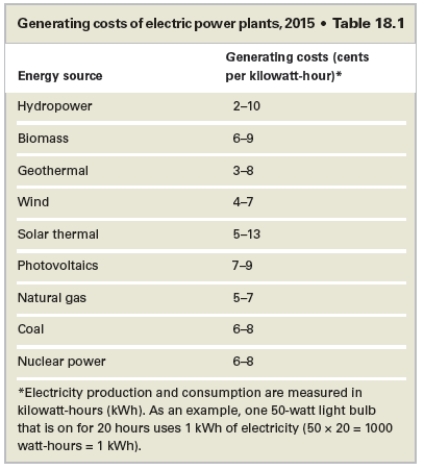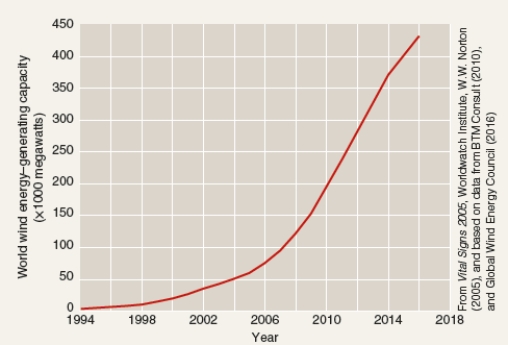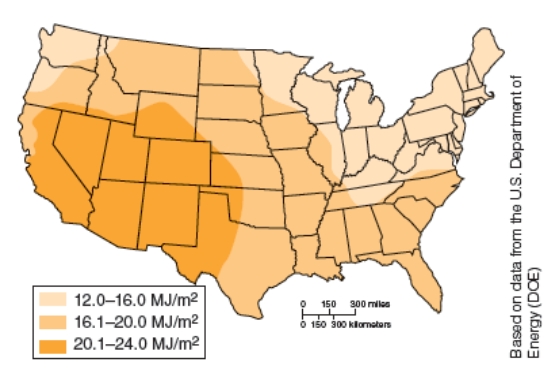A) the pressure of hot water from a deep well turns a turbine and generates electricity.
B) Steam separated from hot water pumped from underground turns a turbine and generates electricity.
C) water is transferred from a deep well to a coil exposed to solar radiation to heat the water sufficiently to generate steam, which turns a turbine and generates electricity
D) a pipe with heated oil is sent deep into Earth to initiate a volcanic eruption then is tapped so that the energy can be used to generate electricity.
E) water is transferred from a deep well into a hot water tank, which is kept at a constant temperature by combustion of natural gas.
Correct Answer

verified
Correct Answer
verified
Multiple Choice
Solar thermal energy systems are inherently more efficient than photovoltaic solar cell systems because solar thermal systems
A) diminish reliance on fossil fuel systems.
B) reduce the potential of global warming.
C) do not have any moving parts.
D) concentrate the sun's energy.
E) do not produce any air pollution.
Correct Answer

verified
D
Correct Answer
verified
Multiple Choice
The National Appliance Energy Conservation Act
A) sets national energy efficiency standards for refrigerators, washing machines, ovens and other appliances.
B) mandates the recycling of "waste" heat in all domestic devices such as refrigerators, freezers, and microwaves.
C) offers rebates to homeowners who install renewable energy sources such as solar panels in their homes.
D) changes the regulations that govern electric utilities allowing these companies to make more money by generating less electricity.
E) provides for infrastructure improvement of electric grids to recover 10 percent of electricity lost during transmission.
Correct Answer

verified
Correct Answer
verified
Multiple Choice
All of the following are disadvantages of photovoltaic solar cell technology except
A) the manufacturing process requires toxic industrial chemicals.
B) the amount of land needed to hold the number of solar panels required for large-scale use.
C) each panel's low efficiency at converting solar energy to electricity.
D) the steadily increasing manufacturing cost per watt over the last 35 years.
E) the carbon dioxide emissions that contribute to greenhouse gases.
Correct Answer

verified
Correct Answer
verified
True/False
A major concern of wind power is the deaths of birds and bats.
Correct Answer

verified
Correct Answer
verified
Multiple Choice
According to the data below, which of these technologies has the highest cost per kilowatt-hour? 
A) hydropower
B) solar thermal
C) nuclear power
D) photovoltaics
E) coal
Correct Answer

verified
Correct Answer
verified
Multiple Choice
All of the following are options to conserve energy at home except
A) improve insulation.
B) install double paned windows.
C) keep a beverage refrigerator in the garage.
D) use thermal lined curtains.
E) caulk cracks on exterior of home.
Correct Answer

verified
Correct Answer
verified
Multiple Choice
In rural areas of developing countries, photovoltaic cells are used for all of the following purposes except
A) charging batteries.
B) heating hot water heaters.
C) providing refrigeration for vaccines.
D) grinding grain.
E) pumping water.
Correct Answer

verified
Correct Answer
verified
Multiple Choice
Which of the following actions is mismatched with its type of energy savings?
A) setting the thermostat on the hot water heater lower: energy conservation
B) turning off lights when a room is not in use: energy conservation
C) replacing incandescent bulbs with compact fluorescent: energy efficiency
D) "superinsulating" a building: energy efficiency
E) installing a new condensing furnace to replace a conventional gas furnace: energy conservation
Correct Answer

verified
Correct Answer
verified
Multiple Choice
The major advantage of a fuel cell over a standard battery is that
A) fuel cells are less expensive to produce and operate than standard batteries.
B) a fuel cell generates electricity without the need for positive or negative electrodes but batteries have these electrodes.
C) fuel cells produce power as long as they are supplied with fuel whereas batteries store a fixed amount of energy.
D) fuel cells generate small amounts of CO2 and sulfur oxide emissions compared to the large amounts emitted by standard batteries.
E) fuel cells do not have any advantages over standard batteries
Correct Answer

verified
C
Correct Answer
verified
Multiple Choice
Electric meters can run backward for homeowners participating in net metering. What does this mean?
A) homeowners receive meter credit for excess energy they generate and supply to the utility's power grid
B) the up front costs for installing renewable energy is recovered by rewinding the home's electric meter
C) if a homeowner uses less energy in one month than the previous month, then the difference is subtracted from the electric meter
D) homeowners who voluntarily cut back on air conditioning use are granted an electric credit
E) a radio controlled electric meter for remote monitoring allows the utility company to stop the meter during peak demand periods
Correct Answer

verified
Correct Answer
verified
Short Answer
A form of renewable energy that relies on flowing or falling water to generate electricity is known as __________.
Correct Answer

verified
Hydropower
Correct Answer
verified
Multiple Choice
Which of the following biomass energy sources is incorrectly matched with its biofuel product?
A) sugar cane: alcohol
B) oil used to make French fries: biodiesel
C) clay: biogas
D) manure: methane
E) wood: charcoal
Correct Answer

verified
Correct Answer
verified
Multiple Choice
Which of the following is the most promising solution to our current and future energy needs?
A) tapping into fossil fuel reserves
B) revert to using only biomass fuels
C) federal economic stimulus money to purchase newer cars
D) conservation and increased efficiency
E) deciding on one renewable resource for investment and development
Correct Answer

verified
Correct Answer
verified
Multiple Choice
Energy efficiency is defined as
A) energy that escapes in an unusable form.
B) energy in bonds broken (minus) energy in bonds formed.
C) using fossil fuels instead of renewable alternative energy.
D) using less energy to accomplish a given task, by using new technology, for example.
E) using less energy by reducing energy use and waste, for example.
Correct Answer

verified
Correct Answer
verified
Multiple Choice
Fuel cells produce electricity 1. that cannot be stored and must be used immediately. 2. indefinitely, as long as they are supplied with fuel (hydrogen) . 3. from fossil fuel added to the chemical reaction. 4. from solar energy that has been stored as chemical energy.
A) 1 only
B) 2 only
C) 3 only
D) 4 only
E) 2 and 4
Correct Answer

verified
Correct Answer
verified
Multiple Choice
Tidal energy cannot become a significant resource worldwide because
A) the accompanying tidal waves cause too much environmental destruction.
B) the equipment required to harness this energy is not yet
C) few areas have large enough differences in water level between high and low tides to make power generation feasible.
D) sand damages the equipment
E) tidal energy can become a significant resource worldwide.
Correct Answer

verified
Correct Answer
verified
Multiple Choice
What conclusion can be drawn from analysis of the data shown below? 
A) If the current trend continues, the world wind energy-generating capacity in 2020 will doubled.
B) The growth of global wind energy consumption is linked to global economy.
C) Global wind energy-generating capacity has consistently increased in the last 10 years.
D) Global wind energy-generating capacity has consistently decreased in the last 10 years.
E) Global wind energy-generating capacity has fluctuated considerably in the last 10 years.
Correct Answer

verified
Correct Answer
verified
True/False
Diesel fuel burns much cleaner than biodiesels.
Correct Answer

verified
Correct Answer
verified
Multiple Choice
According to the U.S. map below of average daily total of annual solar energy, which state is least suited for producing electricity from solar energy? 
A) Nebraska
B) New York
C) New Mexico
D) North Carolina
E) North Dakota
Correct Answer

verified
Correct Answer
verified
Showing 1 - 20 of 70
Related Exams